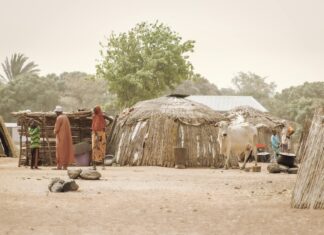When revered Juju musician Chief Ebenezer Fabiyi, otherwise known as Ebenezer Obey released his popular song back then in the 1970s eulogizing all the major kingdoms and traditional rulers (Obas) in Yorubaland, the ancient kingdom of Owo and its Oba, the Olowo were surprisingly left out.
The inexplicable omission is still baffling to many, especially the older generation sons and daughters of Owo, some of whom are yet to forgive the Juju music maestro. But one notable message from the song which everyone agrees with, without doubt, is the lyric that says that a town cannot exist
without a head. In the case of Yorubaland, an Oba.
Among the Yoruba people, as soon as a reigning monarch departs, arrangements are quickly made for a new Oba, while in the interim, a regent is automatically installed or a council of chiefs empowered by tradition to act pending the installation of the next Kabiesi.
By the tradition of the Yoruba people, a king does not die, they only join their ancestors.
So, it was for Oba Victor Olateru-Olagbegi, the 32nd Olowo of Owo who joined his ancestors on April 18, 2019. The cutting of all tress at the market square as tradition demands broke the news to the dwellers of the kingdom.
Oba Olagbegi ascended the throne in 1999 and was not given recognition until 2003 when late Governor Olusegun Agagu presented him the Staff of Office. He reigned for almost 20 years. He fought many battles and challenges before his ascension and subsequent coronation.
His main challengers, who were also members of the Olagbegi Ruling House, claimed that Oba Olagbegi did not have the right to the throne being the direct son of the previous Olowo, Oba Olateru Olagbegi, who was banished to Okitipupa, also in the state.
Owo is ruled by heirs chosen from among the princes from the three ruling families, Ogunoye, Ajike and Olateru Olagbegi, after consultation with Ifa oracle. The king is often assisted by appointed chiefs collectively known as Edibo Ologho and other chiefs such as Sasere, Ojumu Odo, Elerewe Ayida,
Ajana Atelukoluko, the Ifa priest of Owo and Akowa Loja who is the head of chiefs in Iloro Quarters of Owo.
According to Owo traditions, the Olowo is often appointed by kingmakers in which, the Iloro chiefs under the leadership of Akowa Loja play a significant role. The Iloro chiefs comprise the senior chiefs collectively known as Ighare and others collectively known as the Ugbama. Both play major roles during installation of a new Olowo.
Enter Oba Ajibade Gbadegesin Ogunoye
As soon as Oba Victor Olateru-Olagbegi joined his ancestors at the age of 77, and after the traditional mourning period was over, the process to choose the next Olowo began and Prince Ajibade Gbadegesin Ogunoye, from the Ogunoye ruling house, following tradition and ifa consultations, emerged as the next ruler of the ancient kingdom out of 18 princes that vied to occupy the throne. His coronation rites thereafter began and on Friday
August 23, 2019, Prince Ogunoye was installed the 33rd Olowo of Owo kingdom, thus ascending the throne of his forefathers after an elaborate ceremony.
The traditional rites, which started at dawn, was attended by hundreds of residents of the town and well-wishers. The new king according to Chief Olanrewaju Famakinwa, the Ojumu of Owo, chose the sword of peace in the course of the rites.
Traditionally, before a king is installed, he will have to choose a sword at Oke Mapo and it is believed that whichever one he chooses will tell how his reign will be.
Coincidentally, the new king chose the same sword chosen by his father more than 30 years ago and the sword represents peace. The Agba Omolowo, Chief Idowu Oludaye, said it was a new dawn for the ancient town because there was a new king.
The new monarch has been described as a man of honour, patience and humility, and it is hoped that his reign would bring peace, prosperity and development to the town.
The formal coronation of the new Olowo would hold on September 8 with the Iwuye ceremony to be followed on December 14 by the official presentation of the Staff of Office to the monarch by the Ondo State governor, Arakunrin Rotimi Akeredolu, an indigene of the kingdom.
Oba Ogunoye was selected as Olowo on July 12 after garnering 14 votes from the 15 kingmakers, the senior Omolowos, who have sole responsibility to select the king for the ancient town, in an election conducted by officials of the local government.
The new king a former civil servant, voluntarily resigned as permanent secretary in the Ondo State Civil Service to enable him vie for the throne of Olowo of Owo kingdom.
A kingdom, her people, her tradition
The people of Owo are found in Ondo State of Nigeria. It was the capital of a Yoruba-city-state between 1400 AD and 1600 AD.
Owo is a Local Government Area of Ondo State. It has a population of 222, 262 based on 2006 population census. The city is bounded by Ifon, Uso and Benin. The people are predominantly farmers and art workers (sculptors and ivory carvers). Their agrarian land is used to plant cash and food crops such as cocoa, plantain, yam, rubber, cassava, cocoyam etc.
The people are led by a king titled ‘Olowo of Owo’. The people are predominantly farmers that grow food and cash crops. The main language spoken here is the Owo dialect and Yoruba language.
Owo traces its origins back to the ancient city of Ile-Ife, the cradle of Yoruba culture. Oral tradition claims that the founders were the sons of the Yoruba deity Oduduwa, who was the first ruler of Ile-Ife. The early art-historical and archaeological records reference these strong affiliations with Ife culture. Owo, which has Benin as its neighboring kingdom has the same culture. The transmission of courtly culture flowed in both directions (Owo and Benin). The skill of Owo’s ivory carvers was also appreciated at the court of Benin.
It came under British rule in 1893. After Nigeria declared independence in 1960, the kingdom was part of the Western Region until 1967 when it became part of Western State. Owo and its indigenes were said to play significant roles in the politics of the First Republic in Nigeria. In 1976, it became part of the newly created Ondo State.
Owo has the largest palace (Aghofen) in Africa which was declared national monument by the federal government of Nigeria. The Owo Palace had as many as 100 courtyards (Ugha). Each courtyard had a specific function and was dedicated to a particular deity. The largest of the court is twice as big as an American football field. The courts were built in style and decorated with materials such as quartz, pebbles, broken pottery, and statues.
Owo people are good dancers and also rich in music. The list of traditional dances includes; the Ajabure Traditional Dance which is performed as part of the funeral for the dead. There is also the Totorigi dance for men and women. The dancers have a beautiful costume and dressing which consists of a thick woolen material (aso oke or ofi) worn by both male and female. The females tie the cloth up to their chest with coral beads on (neck, wrist and ankle).
They also use black-horse-tail which is moved with dexterity while dancing to their music accompanied by the agogo (gong) and drums.
The Igogo festival is a festival held in Owo. It comes up annually in September to honor Queen Oronsen, a mythical wife of Rerengejen. During the festival, the Olowo of Owo and high chiefs of Owo Kingdom dress like women with coral beads, beaded gowns and plaited hair. There is also the wearing of headgears, caps and the beatings of drums. Firings of guns are prohibited in the festival.
By the end of the middle of 15th century, Owo town had come under the influence of Benin kingdom. Thus, Owo became influenced by several facrors: ·Architecture: The houses of Owo people have fluted walls like the people of Benin.
Religion:
The religious activities of the Benin and Owo people look alike. For example, the Owo people perform the same ritual of “Igwue” like the Benin.
Politics:
The Owo people adopt chiefly titles like the Benin people.
Regalia:
The royal regalia is common in both cities.
Traditional Rulers:
The Oba of Benin and the Olowo of Owo use the same type of ceremonial sword that has looped handle.
Sculpture:
The styles of their sculptures are the same; their ivory carvings are difficult to distinguish which city has them.
In Owo, the wooden ram-heads are placed in the ancestral shrines which are a common culture in both cities. · In some shrines also, there are found carvings of human heads bearing ram horns, long and curve-like over the head.
The face of the ram-head is smoothly modeled and the neck is encircled with bead-like rows of wood, recalling the Benin bronze head. Similarly, as a result of the influence of Ife on Owo, both cities share common characteristics in their works of art. Both Ife and Owo heads have the following characteristic features in common.
They have modeled face.
They have slanted eyes.
They have vertical striations.
Thus, Owo art has a historical and stylistic link between the art of ancient Ife and Benin. Among the rich cultural heritage of Owo people are the following objects. Round-headed man with distinct hair-line which may represent the edge of a cap, folding ‘oriental’ eyes without pupils (15thC AD) ·
Terra-cotta representation of a hand presenting a lizard or rat. The thumb is decorated with a ring, while the wrist is heavily beaded (15thC AD; 16.1cm high) among other features. In the recent past, some Museum archaeologists who are trained experts in digging out and excavating the ancient works of art or artefacts had carried out successful excavations in Owo town. They are Late Prof. Ekpo Eyo, the first indigenous Director of Federal Department of Antiquities, now National Commission for Museums and Monuments, and Mrs. Anthonia K. Fatunsin, the First Nigerian female
Archaeologist, and the first Nigerian woman to head National Museum, Ibadan Oyo State. One of such sites of excavation was carried out at a grove named Igbo Laja by Late Prof. Ekpo Eyo in 1971, where a lot of discoveries of artefacts were made which include human and animal terra-cotta sculptures, polished stones axes, cowries, palm nuts and fragments of metal gongs.











